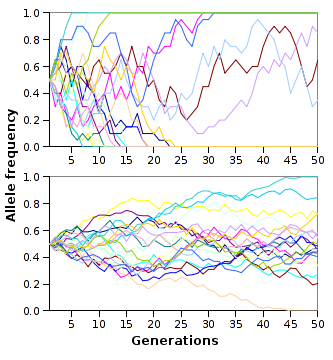adaptive value on:
[Wikipedia]
[Google]
[Amazon]
 The adaptive value represents the combined influence of all characters which affect the fitness of an individual or population.
The adaptive value represents the combined influence of all characters which affect the fitness of an individual or population.

 The adaptive value represents the combined influence of all characters which affect the fitness of an individual or population.
The adaptive value represents the combined influence of all characters which affect the fitness of an individual or population.
Definition
Adaptive value is an essential concept of population genetics. It represents usefulness of a trait that can help an organism to survive in its environment. This heritable trait that can help offspring to cope with the new surrounding or condition is a measurable quantity. Measuring adaptive value increases our understanding of how a trait helps an individual's or population's chances of survival in a particular set of conditions.Measurement
The adaptive value can be measured by contribution of an individual to the gene pool of their offspring. The adaptive values are approximately calculated from the rates of change in frequency andmutation–selection balance Mutation–selection balance is an equilibrium in the number of deleterious alleles in a population that occurs when the rate at which deleterious alleles are created by mutation equals the rate at which deleterious alleles are eliminated by selecti ...
.

Examples
* Avoiding Predators Some plants use indirect plant defenses to protect themselves against theirherbivorous
A herbivore is an animal anatomically and physiologically evolved to feed on plants, especially upon vascular tissues such as foliage, fruits or seeds, as the main component of its diet. These more broadly also encompass animals that eat n ...
consumers. One of defensive mechanism that plants employ is to release volatile chemicals when herbivores are feeding from them. The odor of volatile chemical attracts carnivores
A carnivore , or meat-eater (Latin, ''caro'', genitive ''carnis'', meaning meat or "flesh" and ''vorare'' meaning "to devour"), is an animal or plant whose nutrition and energy requirements are met by consumption of animal tissues (mainly mu ...
’ attention, and they get rid of herbivores by eating them.
* Sexual Reproduction Advantages Sexual mimicry is common among animals. Male cuttlefish
Cuttlefish, or cuttles, are Marine (ocean), marine Mollusca, molluscs of the order (biology), suborder Sepiina. They belong to the class (biology), class Cephalopoda which also includes squid, octopuses, and nautiluses. Cuttlefish have a unique ...
es uses this strategy to gain advantage over other males competitor. They mimic female cuttlefish's marking to fool guarding male and fertilize their females. This strategy has more success rate than normal courtship.
See also
*Adaptation
In biology, adaptation has three related meanings. Firstly, it is the dynamic evolutionary process of natural selection that fits organisms to their environment, enhancing their evolutionary fitness. Secondly, it is a state reached by the p ...
* Evolution
Evolution is the change in the heritable Phenotypic trait, characteristics of biological populations over successive generations. It occurs when evolutionary processes such as natural selection and genetic drift act on genetic variation, re ...
External links
*http://www.talkorigins.org/indexcc/CB/CB950.htmlReferences
{{evolution Evolutionary biology terminology